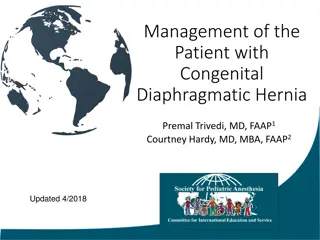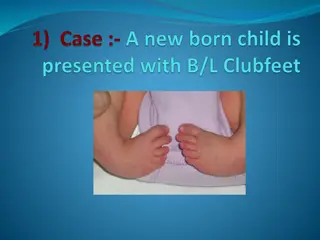Overview of Cyanotic Congenital Heart Diseases (CCHD)
This content provides detailed information and images on various types of Cyanotic Congenital Heart Diseases (CCHD) including CCHD with low PBF, CCHD with high PBF, TOF equivalents, Eisenmenger syndrome, inter-circulatory mixing, and more. It explores causes of cyanosis, classifications based on physiology, and different conditions associated with CCHD. The visuals aid in understanding the complexities of these heart diseases.
Download Presentation

Please find below an Image/Link to download the presentation.
The content on the website is provided AS IS for your information and personal use only. It may not be sold, licensed, or shared on other websites without obtaining consent from the author.If you encounter any issues during the download, it is possible that the publisher has removed the file from their server.
You are allowed to download the files provided on this website for personal or commercial use, subject to the condition that they are used lawfully. All files are the property of their respective owners.
The content on the website is provided AS IS for your information and personal use only. It may not be sold, licensed, or shared on other websites without obtaining consent from the author.
E N D
Presentation Transcript
CYANOTIC CONGENITAL HEART DISEASE CCHD with low PBF and no PAH CCHD with low PBF and PAH CCHD with high PBF CCHD with near normal PBF 1. 2. 3. 4.
CYANOTIC CONGENITAL HEART DISEASE CCHD with low PBF and no PAH 1. TOF 2. TOF equivalents (PS with VSD like pathology) 3. Pulmonary atresia with IVS 4. PS with ASD 5. Ebstein anomaly of TV
CYANOTIC CONGENITAL HEART DISEASE TOF equivalents A. DORV+ VSD+ PS B. D-TGA + VSD+ PS C. L-TGA + VSD+ PS D. Tricuspid Atresia + VSD + PS E. Single Ventricle + PS F. Truncus Arteriosus with small pulmonary arteries
CCHD with Low PBF & PAH Eisenmenger syndrome
CCHD WITH HIGH PBF Inter circulatory mixing (admixture physiology) Venous level: TAPVC Atrial level : Single Atrium, Tricuspid Atresia, HLHS Ventricular level : Single ventricle Arterial level: Truncus Arteriosus Transposition Physiology D TGA Taussing bing anomaly
CCHD WITH NEAR NORMAL PBF Pulmonary Arterio Venous Fistula Anomalous drainage of vena cava to Left Atrium Un roofing of coronary sinus in to Left Atrium
CCHD CLASSIFICATION TOF physiology Transposition physiology Admixture physiology Pretricuspid- TAPVC, HLHS, TA, single Atrium Post-tricuspid- single Ventricle, TA Eisenmenger physiology Ductus dependent physiology Ductus dependent pulmonary circulation- PA Ductus dependent systemic circulation- HLHS Near normal physiology- Pulmonary AV fistula Miscelloneous- Ebstein anomaly, PS + ASD
CAUSES OF CYANOSIS AGE BIRTH CAUSE OF CYANOSIS 1. D TGA 2. Obstructive TAPVC 3. Tricuspid atresia 4. Pulmonary atresia with hypoplastic RV 5. TOF (severe PS) 1. D TGA 2. Pulmonary Atresia 3. Tricuspid atresia 4. Ebstein 5. Critical PS 1. TOF 2. TGA 3. Admixture lesions 4. TAPVC 5. SV 6. DORV 7. Truncus arteriosus 1stweek > 1 week
HEART FAILURE 1STday of life AGE Causes of Heart Failure 1. Large AV fistula 2. Congenital severe PR/ severe TR 3. Premature infant with Large PDA 4. Critical AS 5. Tachyarrthythmia/ bradyarrhythmia 6. HLHS 1. Coarctation of Aorta 2. Critical AS 3. Critical PS 4. Obstructed TAPVC 5. HLHS 1. Coarctation of Aorta with large PDA 2. Large VSD 3. Large PDA 4. AV septal defect 5. TGA with nonrestrictive VSD 6. Truncus Arteriosus 1. VSD with PDA 2. ALCAPA 3. Aortoventricular tunnels 4. Any of the above conditions 1STweek of life 1STmonth of life 6 month of life
Decreased PBF Increased PBF Presentation at Any age Neonate / Infant Appearance Comfortable Sick, Lethargic, Irritable Cyanosis Mild - Severe Mild (except TGA with intact IVS) Squatting /Cyanotic spells Common Uncommon Feeding difficulty / Sweating Absent Present Failure to thrive Absent Present Weight Gain Normal Suboptimal Recurrent LRI No Yes Tachypnea Absent Present Heart size Normal Cardiomegaly CHF, Tachycardia, S3, S4 Absent Present CXR Olegemia, No Cardiomegaly Plethoric Lungs, Cardiomegaly
RECURRENT RESPIRATORY TRACT INFECTION 2 or more admissions in six months or three admissions for Pneumonia in any time frame 3 annual episodes of documented bronchitis, bronchiolitis, or pneumonia
LRTI IN CHD Compress the adjacent bronchi and bronchioles Engorgement of pulmonary arteries Stasis of secretion s Microatel ectasis PBF
LRTI IN CHD Increased mucus secretion Goblet cell hyperplasia
Abnormalities of the respiratory mucus or defects in the mucociliary function Structural defects of cilia or secondary to various infections Defects in clearance of airway secretions Reduced ciliary movement
Decreased immune mechanism (syndrome) blood pooling in lungs- bacterial growth























